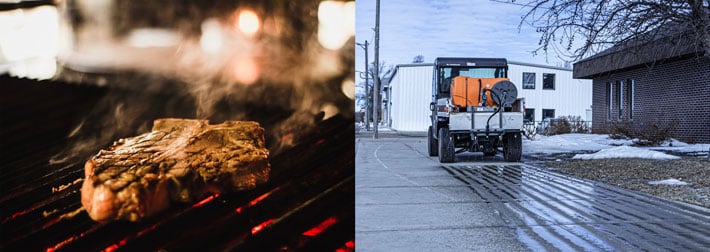
You might be thinking about starting to use liquids in your operation but are wondering how to make the switch. You may know the benefits, and understand why we [as an industry] need to make this change, but how do we actually make the change? In this post, we will discuss how you can make the leap from rock salt to liquid brine.
Understanding Why Brine is Necessary
Although the idea of making the switch seems simple enough, the beginning of the process is usually where these types of things die on the vine, because we either try to start too big or we try to start at a point where it's a bit unrealistic. So, what I recommend we do is we think about it in terms of bags of salt versus small tanks of salt brine. So let's put this in perspective first. What I can do with five to six 50 lb. bags of salt, I can do with one 2.5 - 3 gallon mix of brine. And so...
|
SALT BRINE USES LITERALLY 6-8 TIMES
|
So, never mind the amount of salt itself but just the amount of effort. Think about it in terms of if I were to take this small brine sprayer and fill up a couple of gallons straight from a tank that's off the back of a truck or a UTV; compared to dealing with a sidewalk area, where I'd have to open 5 to 6 bags of rock salt minimum to have the same square footage of application.
So which one is going to take more effort? Fill up this tank or tear apart 5 to 6 bags, dump it into a spreader, and take the spreader down the sidewalk? We know what happens with that; It gets clumped and doesn't spread properly, and we end up having to do a lot of it by hand. Then the application rate becomes uneven and inconsistent with a lot more waste. Versus if we take this one single tank with an even application. Never mind that now we've got to dispose of these bags (and the mess that that creates in the process).
The choice is yours. Keep in mind there was a point in time years ago when we didn't even have this rock salt available to us, how did we deal with situations back then?
We either dealt with it or used a different tool. Years ago we used to chip ice, then we started to melt it then we started to actually try to prevent it. Let's take the bag out of the picture. I can guarantee you, if you only have liquid brine as your tool now, you'll figure out how to make it work. But really the only way to make liquid brine work is to make sure that rock salt goes away.

Start Off With A Trial
What I don't recommend is that we do this on a grand scale. I recommend that we first do this on a small scale, maybe just a small section of sidewalk, even just try it at your own home. The name of the game though when you're using liquid is prevent the bond, prevent the bond, prevent the bond. The liquid brine must go down before accumulation in order for it to prevent the bond and give you that clean scrape and then afterward you can re-apply. But think about it, applying brine versus many bags of rock salt is the name of the game. You will achieve it if you just take that bag out of the picture. Experiment with it. Just try it for a few storms.
So, let's relate this to another cooking analogy. Think about barbequing. If you've always barbequed with a gas grill and you've heard really good things about charcoal like, "It's the older way but it's much more efficient heat. It gives it better flavor." why wouldn't you do it?
The gas grill is the bag of salt, the liquid is the charcoal. They both produce a similar result, but one is perceived and has been proven to be better. What you wouldn't want to do is purchase a really expensive steak, knowing that you're always used to doing it the bagged salt/gas grill way, and then quickly put it on to the charcoal method.
You're likely going to either burn it or it's not going to turn out the result that you want on the first time. So, it does take some practice, some testing and gaining confidence and, "Oh okay so this is how this works compared to how I used to do it with this method or this tool".
I hope this article has helped you understand how you can easily make the switch from rock salt to liquid brine. To shop our variety of liquid brine sprayers, visit our website. If you have any questions, feel free to comment below and we'll get back to you.
Interested in more FREE TRAINING? Here are links to the complete course:
Why is Using Liquid Brine Important? [1 of 10]
Environmental Benefits of Liquid Brine [2 of 10]
Economical Benefits of Liquid Brine [3 of 10]
Level of Service Benefits of Liquid Brine [4 of 10]
Rock Salt vs Liquid Brine [5 of 10]
Preventing the Bond of Snow & Ice with Liquid Brine [6 of 10]
What are the Barriers of Switching to Liquid Brine Deicing? [7 of 10]
Why Aren't More Clients Asking for a Liquids Approach? [8 of 10]
How do we Make the Change to Liquids? [9 of 10]
Liquid Brine Spraying Techniques [10 of 10]



